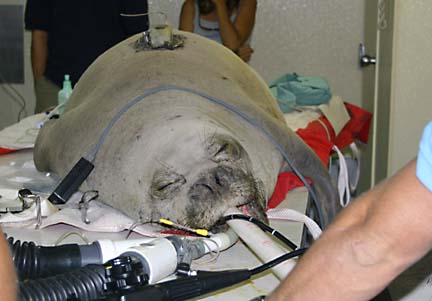
An ailing Hawaiian monk seal was sedated yesterday by National Marine Fisheries Service veterinarians. The marine mammal has a 5-inch fishhook lodged in its esophagus.
Injured monk seal
awaits risky surgery
on stomach
The Hawaiian monk seal that was airlifted from Kauai will undergo surgery this morning after veterinarians were unable yesterday to remove a swallowed fishhook lodged above its stomach.
Veterinarians located the 5-inch fishhook in the esophagus, just above the entrance to the stomach, said Robert Braun, a veterinarian with the National Marine Fisheries Service.
Veterinarians sedated the monk seal -- called "TT-40" after the identification tag that was placed on its flipper earlier this year -- and inserted an endoscope (a fiber-optic viewing device) through its mouth down to the stomach.
The two-hour procedure began at 9:04 a.m. yesterday at a laboratory at Marine Corps Base Hawaii in Kaneohe. Veterinarians said they will try to remove the hook by cutting through the stomach in a risky and delicate procedure that could take even longer.
"Unfortunately, where the hook is and the type of hook the animal has isn't removable with the endoscope," said Dr. Martin Haulena, a veterinarian from the Marine Mammal Center in Sausalito, Calif., flown in to anesthetize the seal. "We have to go in through a more invasive procedure in order to specially remove it."
Surgery on a Hawaiian monk seal is especially tricky, Haulena said, but the seal faces possible life-threatening organ damage if the hook stays in its esophagus.
The seal is now resting at the Marine base. Braun said the chances for survival for the 500-pound, 20-year-old male seal are good, and they hope to release him back into the wild after recovery, which could take weeks or months.
Coast Guard officials airlifted the seal on a C-130 cargo plane from Kauai to Oahu on Friday after it was spotted with fishing line coming from its mouth. Officials with the National Oceanic and Atmospheric Administration removed about 15 feet of fishing line last week at the Kewalo Research Facility.
NOAA was able to locate the seal because of the satellite tracking device they attached earlier this year.
Brad Ryon, a NOAA marine biologist, said while endangered monk seals have been hooked before, TT-40's case is unusual.
"It's the only one in recent years that swallowed it," he said. "Most of them, the hooks are still in their mouths."
Ryon also said a hooked Hawaiian monk seal is usually reported every three to four months, but recently there were three hooked seals spotted. "A group of three animals is extremely unusual," Ryon said.
Another hooked Hawaiian monk seal, tagged as RH-40, was spotted last week off Poipu, Kauai, but the hook fell out on its own, said Ryon. A third hooked seal was last spotted Monday night in Mokuleia, but NOAA was unable to locate it.
If anyone sees a Hawaiian monk seal in distress, call NOAA's 24-hour emergency hot line toll-free at (888) 256-9840.
The Hawaiian monk seal has been on the endangered species list since 1976, and there are only about 1,300 left in the world.
— ADVERTISEMENTS —
— ADVERTISEMENTS —
